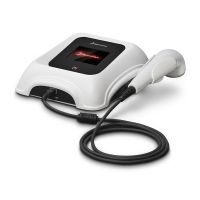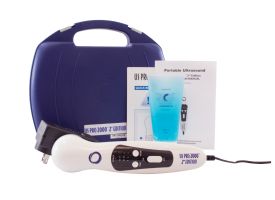 Written by Morgan Hopkins, DPT, CMTPT
Written by Morgan Hopkins, DPT, CMTPT
When hearing the term ultrasound, most people will immediately jump to its utilization as an imaging technique in diagnostics or pregnancy. In fact, according to one study out of England, ultrasound was the second-most prevalent imaging test ordered with 9.51 million ultrasounds performed in a single year. While its use in diagnostics is exceptional, the technique also serves as a commonly used therapeutic modality in recovery and rehabilitative settings. Interestingly, the use of ultrasound therapy as a treatment has been around for decades dating back to the1930s, and has helped millions of individuals in their recovery process. While technology has evolved and evidence-based research on the modality has expanded, knowledge relating to both indications and contradictions has grown exponentially. Follow along as we break down the safe use of Ultrasound Therapy and review some of our favorite devices on the market today.
Ultrasound therapy is generally considered both safe and therapeutic when used properly and for the appropriate indications. Suitable application involves choosing the correct intensity, frequency, and duration that aligns with your specific treatment goals and using the device according to the manufacturer’s recommendations. It is important that overexposure to any one location is avoided, as this can increase the risk of burns on the skin surface and can even cause internal bleeding and scarring in extreme cases. Note these complications are rare and can be avoided entirely with proper use.
 | Dynatron 125 Portable Ultrasound with Soundhead by Dynatronics View Product |
When using thermal settings, ultrasound therapy will create a mild heat mimicking a warm massage-like sensation for users. In certain cases, you may feel some light tingling or vibrations as the ultrasound waves pass through the tissues, but this is generally a quite pleasant experience.
Recommended: Dynatron 125 Portable Ultrasound with Soundhead by Dynatronics
With proper application, side effects should not occur with ultrasound. That said, if the intensity is too high, minor pain or discomfort may occur - this can be mitigated with a reduction in intensity. As mentioned earlier, burns or other injuries can occur if the device is kept over a specific area for a prolonged period or if the settings are inappropriately set.
While this modality is considered safe for most patient populations, there are certain individuals who should avoid ultrasound therapy. Contraindications for use include individuals during pregnancy, those with implants or pacemakers, near or over open wounds, and around the eyes or genitals. In addition, ultrasound should be avoided over active infections and malignancies as well as over unstable fractures.
 | Roscoe Medical US Pro 2000 Deep Heat Portable Ultrasound Machine View Product |
In terms of the best portable devices on the market, the Roscoe Portable US Pro 2000 Ultrasound Machine ranks at the top of our list. Using clinical-grade technology, this device offers users deep heating capabilities in the comfort of their homes. Designed with an ergonomic setup and equipped with warming features, it puts patient comfort at the forefront.
Included in the device are three variable intensities and treatment durations to accommodate each patient's unique needs. It can be performed as a water immersion ultrasound or standard ultrasound with airtight hardware and comes standard with a travel case, AC/ DC adaptor, ultrasound gel, and an instruction manual.
| Sonicator 740 Therapeutic Ultrasound Unit View Product |
If you are a clinic owner, professional, or individual looking for the best clinical-grade system, the Sonicator 740 Therapeutic Ultrasound Unit tops the charts. With a microprocessor-controlled unit and unique crystal-to-patient technology, it allows sound waves to be emitted directly into the tissues without requiring a metal interface. Offering watertight characteristics and a universal applicator cable it can be used for a wide range of indications and patient populations.
The device offers both 1 and 3 MHz frequencies to address varying tissue depths and is both lightweight and portable. The well-designed interface features large soft-touch controls to facilitate easy setup and adjustment. Offering high reliability and ease of use, it’s a great option for both clinic and home use.
Besides ultrasound therapy, shockwave therapy also sends specific wavelengths into the tissues to promote therapeutic change. While there may be some crossover, the therapies differ in both their mode of delivery as well as the specific conditions they treat.
Shockwave therapy is better suited for conditions that may benefit from tissue stimulation whereas ultrasound helps with the deep heating of tissues. Each is appropriate for specific populations and acuities therefore we recommend consulting with your medical team to determine which may be most appropriate for you.
Ultrasound therapy is a safe and effective therapeutic modality that can be used to reduce pain, improve circulation, enhance deep heating, and promote tissue healing. Appropriate use is essential and ensuring your device is both properly maintained and of high quality is key to reaping the desired benefits. If you or a loved one is interested in learning more, check out our Ultrasound Therapy category page and browse through similar expert-curated articles at our Caregiver University.

Morgan Hopkins is a licensed doctor of physical therapy and freelance medical writer. She practiced clinically in outpatient orthopedics for 8+ years specializing in intramuscular dry needling, dance medicine, and post-operative care. Morgan seeks to be a leader in the continued shift toward preventative healthcare, helping people optimize movement now so they can move for years to come. She is a firm believer in complementary therapies, holistic wellness, and functional fitness and is thrilled to be able to educate others through Rehabmart’s platform.